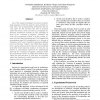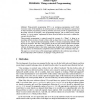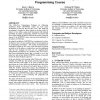ITICSE
2003
ACM
15 years 22 days ago
2003
ACM
In this paper we present a new learning environment to be used in an introductory programming course for students that are non-majors in computer science, more precisely for multi...
VL
2003
IEEE
15 years 23 days ago
2003
IEEE
One of the reputed advantages of end-user programming languages is that they support a given problem doh a set of programming abstractions that are “just right” for the end-us...
VL
2003
IEEE
15 years 23 days ago
2003
IEEE
Models of programming and debugging suggest many causes of errors, and many classifications of error types exist. Yet, there has been no attempt to link causes of errors to these ...
VL
2003
IEEE
15 years 23 days ago
2003
IEEE
A significant challenge in teaching programming to disadvantaged populations is preserving learners’ motivation and confidence. Because programming requires such a diverse set o...
OOPSLA
2004
Springer
15 years 25 days ago
2004
Springer
Programmers tend to understand programs by thinking of concrete examples. Example Centric Programming seeks to add IDE support for examples throughout the process of programming. ...
JIT
2004
Springer
15 years 26 days ago
2004
Springer
Thing-oriented programming (TP) is an emerging programming model which overcomes some of the limitations of current practice in software development in general and of object-orient...
SIGITE
2004
ACM
15 years 28 days ago
2004
ACM
“The Multi-User Programming Pedagogy for Enhancing Traditional Study” (MUPPETS) system has been under development at RIT for the last three years. This multi-user environment ...
MM
2004
ACM
15 years 28 days ago
2004
ACM
In this paper, we describe ChucK – a programming language and programming model for writing precisely timed, concurrent audio synthesis and multimedia programs. Precise concurre...
SOFTVIS
2005
ACM
15 years 1 months ago
2005
ACM
Programming in parallel is an error-prone and complex task compounded by the lack of tool support for both programming and debugging. Recent advances in compiler-directed shared m...
SIGITE
2005
ACM
15 years 1 months ago
2005
ACM
Early in its history as an academic discipline, depth in computer programming was a primary distinguishing factor between IT and older computing disciplines, such as computer scie...



